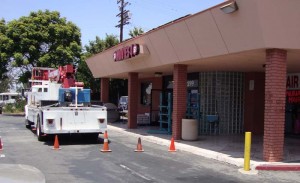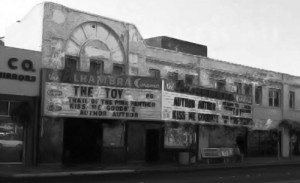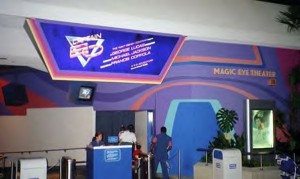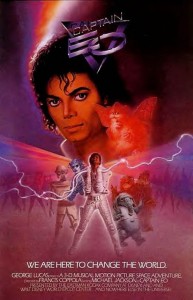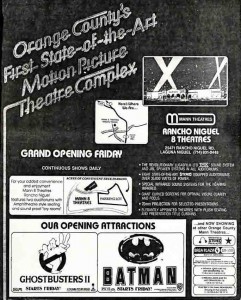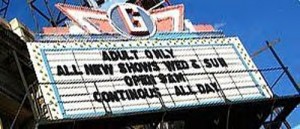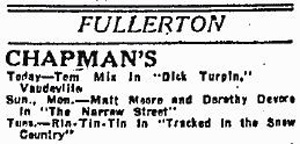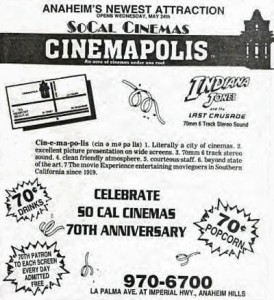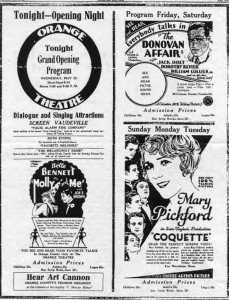Tags: 2 Comments
New Life For The Brookhurst
June 29th, 2009 by
Respond
The Many Births of the Multiplex
June 27th, 2009 by
Respond
Tags: 1 Comment
The Electric Eye Theater & Captain EO
June 26th, 2009 by
Respond
Tags: Comments Off on The Electric Eye Theater & Captain EO
A Sign Of The Times
June 20th, 2009 by
Respond
Tags: Comments Off on A Sign Of The Times
Rancho Niguel 8: A Transitional Marker At 20
June 15th, 2009 by
Respond
This past weekend marked the twentieth anniversary of the Rancho Niguel 8, in Laguna Niguel. Built with spacious, THX certified, auditoriums and a host of higher end amenities, the theatre was a dramatic departure from Mann’s tradition of more budget conscious multiplexes; this upgrade in quality was likely reflective of Mann Theatres having changed ownership shortly before the Niguel 8 was built (namesake Ted Mann sold the chain to Gulf & Western in 1986). The Rancho Niguel was sold to Edwards Theatres in 1991, but temporarily returned to the Mann fold, following Edwards’ bankruptcy. In an odd twist of fate, the theatre had opened at a time when Mann was still a major player within the exhibition industry, but, by the time the Niguel 8 returned to Mann, the company was a mere shadow of it’s former self.
While no longer “state of the art”, the Rancho Niguel 8 remains relatively unchanged from it’s June 13, 1989 opening and continues to aptly serve the Laguna Niguel market. Currently operated by Regency Theatres, the venue stands as a pristine example of late 80’s cinema and historical marker from Mann Theatres’ evolution.
Tags: Comments Off on Rancho Niguel 8: A Transitional Marker At 20
Grand Start Sad Ending
June 13th, 2009 by
Respond
Ninety three years ago, Anaheim’s Grand Theatre opened to great fanfare, with a sold out showing of “Romona”, that was eagerly attended by the county’s top dignitaries and VIPs. Being one of the first Orange County theatres built outside of Santa Ana, the June 12, 1916 opening was a source of great pride for the city of Anaheim. Yet, the Grand’s prestigious start was a far cry from how this “modern wonder of engineering and beautiful luxury” would spend the second half of it’s sixty seven year run.
By the 1950’s, the Grand had begun a rather dramatic slide from prominence, falling victim to the common challenge of being an aging attraction in an ever expanding market of “newer”, “bigger”, and “better”. Facing increasing hardship, the Grand was briefly closed in 1955, before being reopened, as the Garden Theatre; moving in to the realm of B film booking for the next two decades. In an attempt to stay financially viable, this move also resulted in the theatre finding the need to keep pace with a demand for mature content; B schlock gave way to softcore “adults only” films, which ultimately resulted in hardcore pornography by the late 70’s.
In 1978, the theatre was added to the Pussycat chain of adult cinemas and renamed the Pussycat Garden. While only staying open for another four years, the venue became notorious for both the pornographic films being shown and a series of legal battles between the City of Anaheim and the theatre’s controversial operators. In 1983, the city finally managed to shutter the theatre, via condemnation powers, razing the site for newly zoned housing usage. The legal battles continued until the Summer of 1986, when Anaheim managed to reach an out of court settlement with Pussycat for $800,000 (the chain had previously demanded $1.2 million). The one time “pride of Anaheim” was paid to simply go away.
Tags: 1 Comment
General Cinema Art Galleries
June 6th, 2009 by
Respond
Tags: Comments Off on General Cinema Art Galleries
Fox Fullerton Beginning & Future
May 28th, 2009 by
Respond
Tags: Comments Off on Fox Fullerton Beginning & Future
Twenty Years of Cinemapolis
May 25th, 2009 by
Respond
Tags: Comments Off on Twenty Years of Cinemapolis
The Orange Theatre at 80
May 22nd, 2009 by
Respond
Tags: Comments Off on The Orange Theatre at 80


